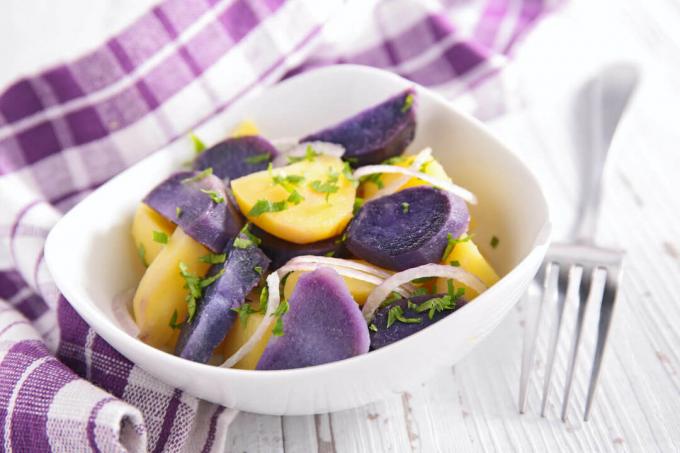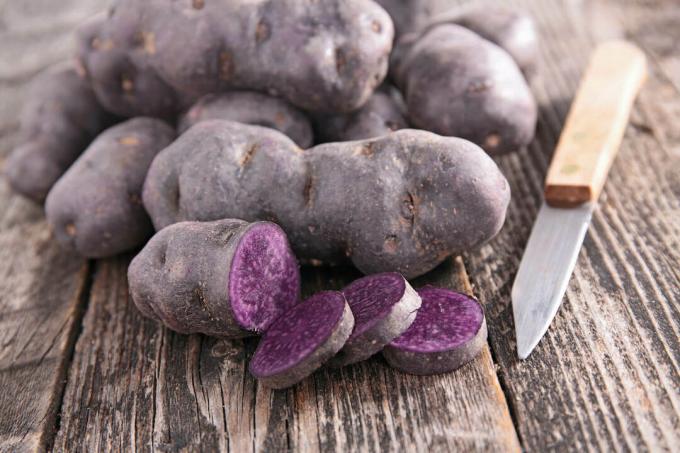Potatoes are not only available in the typical yellow, but also in bright purple and blue colors. We will show you here which varieties provide variety in your kitchen.

The lilac, violet or blue potatoes are available in pretty much every color nuance. Most purple potato varieties are only grown by a few farmers or special enthusiasts and are also less common in stores. However, there is a rich variety of varieties that are also ideal for the home garden.
contents
- Purple potato varieties
- Grow purple potatoes
-
Prepare and use purple potatoes
- How do purple potatoes taste?
- How Healthy Are Purple Potatoes?
- Can you eat blue potatoes with their skins on?
Purple potato varieties
There are around 100 different purple potato varieties. We have listed the most important ones for you below.
- Vitelotte: The 'Vitelotte' potato is a late variety with a distinctive blue and white marbled flesh. It is also often called the truffle potato because of its small, elongated tubers. The purple potato convinces with its spicy, nutty taste.
- Blue Swede: The potato 'Blue Swede', also called 'Blue Congo', is a popular waxy variety.
- Blue Elise: The 'Blaue Elise' potato, which also goes by the name 'Violetta', is a waxy and high-yielding variety that can convince with its strong taste.
- Blue Anneliese: The 'Blaue Anneliese' potato is a late, waxy variety. This has only been on the market since 2007. The 'Blaue Anneliese' potato is very productive and only slightly susceptible to late blight.
- St Gallen: The ‘St. Galler' potato is a new variety on the market that largely retains its color after cooking. It is predominantly waxy and has an intense taste.

Grow purple potatoes
Purple potatoes are often more susceptible to cultivation and have lower yields than the yellow varieties used by the industry. Since potatoes only suffer from diseases such as late blight later in the year, since the pressure of infestation increases here by pre-germinating the potatoes indoors, the harvest time is pushed forward by a few weeks and the rot is largely avoided. Cultivation in your own garden is still possible without any problems and ensures a delicious harvest. You can also grow the potatoes in a tub on the balcony with enough space. For this it is important to use soil that covers the high potassium requirements of the potatoes. Here we recommend our potassium-rich Plantura organic tomato & vegetable soil. In our article on Potato Plants we give general tips on how the tubers in the garden are sure to succeed.
Prepare and use purple potatoes
In terms of use, the purple potatoes do not differ from the conventional yellow varieties. The purple potato varieties are also divided into waxy or floury varieties.

This is particularly popular in purple potato salads or mashed potatoes. But the purple potato varieties also taste delicious in a casserole, as a soup or simply as baked potatoes or fries. It is best to cook them with the skin on, as this way the color is lost less. Unfortunately, they often don't last as long in storage as the yellow varieties, but in one way In a cool, dark place, purple potatoes still do well for several weeks after harvest store. Tips on how to make your Store and store potatoes properly, can be found in our special article.
How do purple potatoes taste?
The taste of the purple potatoes depends very much on the variety, but overall it is more nutty to chestnut-like with the potatoes 'Vitolette', 'Blue Swede' or 'Anneliese'.
How Healthy Are Purple Potatoes?
The question often arises whether the purple potatoes with their color can be healthy. The color of the purple potato varieties comes from the pigments contained in the tubers, the anthocyanins. These are secondary plant compounds. These protect the plant from free radicals. Free radicals are metabolic products that occur naturally in the body, but they can damage cells. Anthocyanins can also have a helpful effect on humans, which is why the substances have positive effects attributed to health, for example cardiovascular diseases or high blood pressure will. The purple potatoes can therefore be a useful and healthy addition to the menu.

Can you eat blue potatoes with their skins on?
Here, too, the purple or blue potatoes do not differ from their yellow representatives. Many also wonder if you can eat the purple potatoes with their skins on. But the same applies here as with the well-known yellow potato varieties: Especially potatoes from your own garden and also those in organic quality can be eaten with the peel. Also, when growing in your own garden, keep in mind that you can use any kind of pesticide – too Biopreparations – use according to the instructions for use and stick to the specified ones waiting times. So you can enjoy your purple potatoes carefree.
Would you like to learn more about other potato varieties? Then take a look at our article the 50 best potato varieties past.
